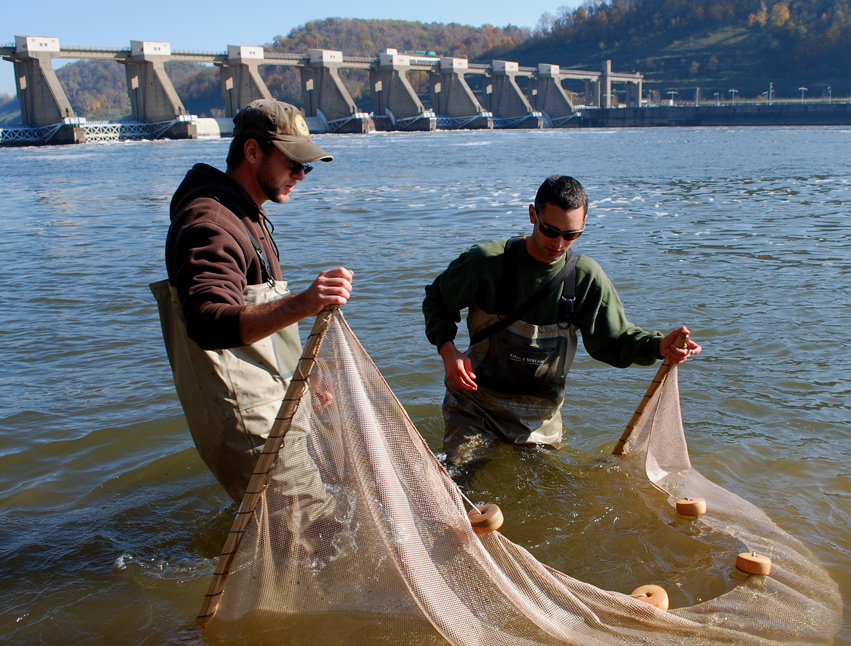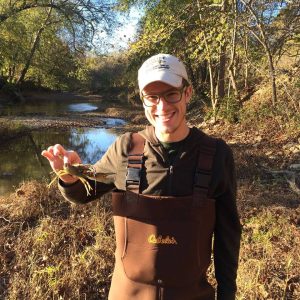We met up with Scott Glassmeyer, a student research assistant in the Fish Division, to get an inside view on his role in the Museum of Biological Diversity.
Scott: “My major is Forestry, Fisheries, and Wildlife, with a specialization in Fisheries and Aquatic Science. I’d always loved fish since I was a kid and before I got into this program, I didn’t know that you could go to college to study fish, or do anything relevant with fish in a job, besides working to commercially collect fish. So, I did research to see if there were any higher education programs that involved learning about fish and aquatics and I found that Ohio State had this program.”
Hilary: “How long have you been a student research assistant in the Fish Division?”
Scott: “Since spring of 2016, but I started as a volunteer in January of 2016 where my primary role was to take older jars containing fish specimens and place them in new ethanol, to better preserve the fish.”
Hilary: “What is the mission of the Fish Divsion?”
Scott: “To preserve historical records of species of fish for future reference and overall long-term data collection and education. It’s a way to validate that this species of fish was recorded in a particular area and a specific species was recorded in general, as fish get misidentified a lot. So it improves a lot of accuracy regarding records.”
Hilary: “What fish are housed here?”
Scott: “Mostly Ohio fish, but we have some from the entire 50 states as well. There are also some fish species from other countries, some saltwater fish, and some aquarium fish here as well.”
Hilary: “Are the specimens here largely donated?”
Scott: “A lot of the specimens are collected through the museum, as well as the Ohio EPA. The Ohio EPA has a division that monitors streams and stream quality statewide and they will collect fish in the process and send them to us.”
Hilary: “How are the fish preserved?”
Scott: “The way the preservation process works is that you put the fish specimens in formaldehyde for a certain amount of time, then you place them in water for about a day, before you start adding the ethanol bit by bit, as you slowly add larger amounts of ethanol to build up the tolerance – and that’s what they stay in. It takes up to a week and a half to two weeks to put them in this preserved state.”
Hilary: “Why is it important to study these fish?”
Scott: “It’s really important to study these fish because it helps you not only understand the water quality of their habitat, but also the intrinsic value of their ecosystems. For example, if you have a stream that’s just concrete because it was filled in, this could possibly only allow for about 5 species of fish to live there, whereas before, when the stream had natural morphological features and geological shapes, there were a lot more species of fish living within in this habitat.”
“A good example of this is from about 6 or 7 years ago, when the 5th Avenue Dam along the Olentangy River near campus was removed. Trees, plants, and wetlands were added along the bank and this natural state contributed to the value of the stream, not just for people, but for the fish as well, as this improved quality increased the level of biodiversity within in and around the river.”
Hilary: “What’s your favorite part about working in the Fish Division?”
Scott: “I love going outside, putting waders on, getting in the stream and finding fish. You can read all you want about how healthy a stream is, but when you go out there and you see the biodiversity in the water as you collect data, you can tell just how healthy the water is and it’s wonderful.”
“I also really like the people who work here with me. Everyone’s very patient here and they take the time to help you out as your learning, which is really nice as learning to identify fish for the first time involves a learning curve.”
Hilary: “What is a project that you’re working on now?”
Scott: “I’ve been editing photographs of fish taken by Brian (my colleague who is the Sampling Coordinator in the Fish Division) and getting them ready to be put into the field guide version of the Fishes of Ohio.”
“The Fishes of Ohio was a guide written in the ‘50s, by Trautman, and then it was revised in the ‘80s by Trautman, and so what we’re working on now would be the next revision. There’s around 190 species or so of fish in Ohio, including invasive species and extinct species, so we’ve been photographing each species listed in the field guide, oftentimes with more than one picture, as you’re taking pictures of what you use to identify them. For example, for some of the sucker species of fish, you have to show the mouth, as that helps with identification. So with these species, there’s some photographs detailing the mouth from underneath, and there’s some side photographs, so that you can see the shape of the head and the mouth from the side for identification.”
Hilary: “Do you photograph the fish in their habitat?”
Scott: “It depends. There was one species of fish where we went out during their spawning season and had the tank set up to photograph them. We caught them, put them in the tank, and took a picture quickly, as they can lose their colors pretty fast. If a fish we find doesn’t have a particular color, we take them, put them in a cooler with an aerator, and take them away from location to photograph them. It’s a time consuming process, with the drive to the specimen’s location, the set-up, hours of wading for fish, and then the tear-down of equipment and the drive back from the site, so taking them away to photograph them can be easier than doing it onsite.
Hilary: “You said that fish lose their colors – what does that mean?”
Scott: “Fish have pigments in their skin, underneath their scales. There’s a lot of colorful fish in Ohio, like darters and minnows, that will have breeding colors and so, during certain times of the year and certain times of the day (or even after they eat) they’ll get a lot of pigment and colors in them. And even if they’re not a colorful fish, their colors can change. For example, you can take a large mouth bass that has some pattern to it and put it into a bucket that’s really light and pull the fish out ten minutes later, and the fish will look really pale. But if you put it in a dark cooler, the fish is going to remain dark and have more color. The stress levels will impact them.”
Hilary: “Do you have a favorite fish species?”
Scott: “This question’s hard. So, my answer changes every month when I discover a new fish, but currently my favorite fish is the Common Dolphin Fish, or the Mahi-mahi. There’s a reason why I like it: So, over 50% of its diet is flying fish, and that’s pretty cool to me. Also, its maximum life span is five years. A marlin or a swordfish can live to be about 27 years of age, and a medium sized Ohio fish species can live to about 15 years. However, the Dolphin Fish lives such a short span of time compared to these fish, yet it grows extremely quickly, as they get up to 36 pounds in 8 months. And it’s really fast too, swimming speeds up to 50 miles an hour.”
Hilary: “With all of your experience and studies, what do you hope to do in the future?”
Scott: “I’d love to work as a fisheries biologist, working for the environment. It’s challenging to get in those types of roles, as they’re very competitive, but I’m going to try.”
 About the Author: Hilary Hirtle is the Faculty Affairs Coordinator at the OSU Department of Family Medicine; her interest in natural history brings her to the museum to interview faculty and staff and use her creative writing skills to report about her experiences.
About the Author: Hilary Hirtle is the Faculty Affairs Coordinator at the OSU Department of Family Medicine; her interest in natural history brings her to the museum to interview faculty and staff and use her creative writing skills to report about her experiences.






